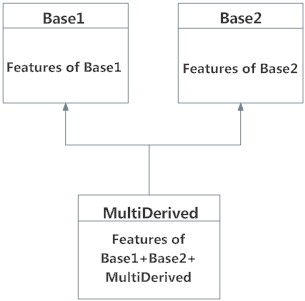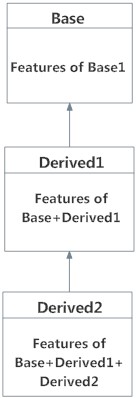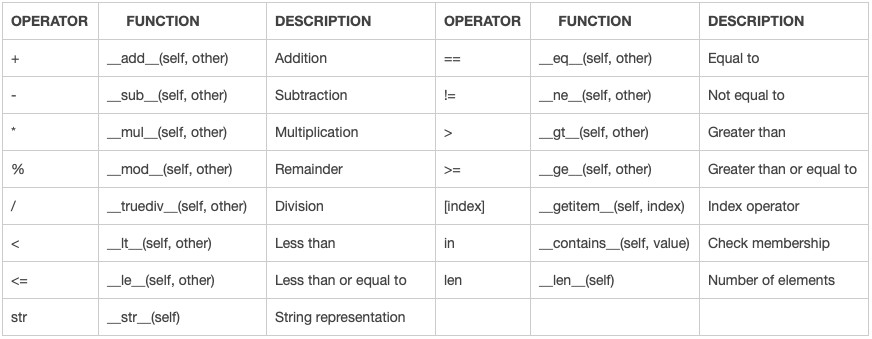Object Oriented Programming
What is Object Oriented Programming?
- Object-oriented Programming is a programming paradigm.
- It provides means of structuring programs so that properties and behaviors are bundled into individual objects.
- Python is a multi-paradigm (functional, object-oriented) programming language i.e it supports different programming approach.
- We can choose the paradigm that best suits the problem at hand, mix different paradigms in one program, and/or switch from one paradigm to another as the program evolves.
Major principles of object-oriented programming system are:
-
Classes, Objects (Instances), Methods
-
Inheritance
-
Polymorphism
-
Encapsulation (Data Abstraction)
Advantages of object oriented programming:
-
Improved software-development productivity:
- Provides improved software-development productivity over traditional procedure-based programming techniques due to below factors.
- Modularity: Provides separation of duties in object-based program development.
- Extensibility: Objects can be extended to include new attributes and behaviors.
- Reusability: Objects can also be reused within an across applications.
- Provides improved software-development productivity over traditional procedure-based programming techniques due to below factors.
-
Improved software maintainability:
-
For the reasons mentioned above, it is easier to maintain.
-
Since the design is modular, part of the system can be updated in case of issues without a need to make large-scale changes.
-
-
Faster development:
-
Reuse enables faster development.
-
Come with rich libraries of objects, and code developed during projects is also reusable in future projects.
-
-
Lower cost of development:
- Typically, more effort is put into the object-oriented analysis and design, which lowers the overall cost of development.
-
Higher-quality software:
-
Faster development of software and lower cost of development allows more time and resources to be used in the verification of the software.
-
Although quality is dependent upon the experience of the teams, it tends to result in higher-quality software.
-
Disadvantages of object oriented programming:
- Steep learning curve:
- The thought process involved may not be natural for some people, and it can take time to get used to it.
- It is complex to create programs based on interaction of objects.
- Some of the key programming techniques, such as inheritance and polymorphism, can be challenging to comprehend initially
- Larger program size:
- Typically involve more lines of code than procedural programs.
- Slower programs:
- Typically slower than procedural programs, as they typically require more instructions to be executed.
- Not suitable for all types of problems:
- There are problems that lend themselves well to functional-programming style, logic-programming style, or procedure-based programming style.
- Applying object-oriented programming in those situations will not result in efficient programs.
Example of Python Class:
class Dog:
species = 'mammal'
legs = 4
def __init__(self, name, age):
self.name = name
self.age = age
def description(self):
print("{} is {} years old".format(self.name, self.age))
def bark(self):
print("Bhaun.. Bhaun..")
dog_a = Dog("Roger", 8)
dog_b = Dog("Lysa", 5)
dog_a.description()
dog_a.bark()
## Output: ##
# Roger is 8 years old.
# Bhaun.. Bhaun..
Classes
- A class is a blueprint for the object.
- It’s an idea or imagination about an object i.e what are its properties and what are its behaviours.
- When class is defined, only the description for the object is defined and hence no memory or storage is allocated.
- Example:- Dog
- Class Attributes (Variables):
- Variables or attributes that are shared by all instances of a class.
- Example:- species, legs
Objects(Instances)
- An object (instance) is an instantiation of a class.
- It’s not an idea anymore; it’s an actual object like a dog named Roger who’s eight years old.
- Example:- dog_a, dog_b
- Instance Attributes (Variables):
- All classes create objects, and all objects contain characteristics called attributes (properties).
- Example:- name, age
Methods
- Methods are functions defined inside the body of a class.
- They can also have their own variables.
- They are used either to get, set or modify the contents of an instance or to define the behaviors of an object.
- Example:- description, bark
Inheritance
- Inheritance is the process by which one class takes on the attributes and methods of another.
- Newly formed classes are called child classes, and the classes that child classes are derived from are called parent classes.
- It provides re-usability of the code.
# parent class
class Bird:
def __init__(self):
print("Bird is ready")
def whoisThis(self):
print("Bird")
def swim(self):
print("Swim faster")
# child class
class Penguin(Bird):
def __init__(self):
# call super() function
super().__init__()
print("Penguin is ready")
def whoisThis(self):
print("Penguin")
def run(self):
print("Run faster")
peggy = Penguin()
peggy.whoisThis()
peggy.swim()
peggy.run()
## Output ##
# Bird is ready
# Penguin is ready
# Penguin
# Swim faster
# Run faster
Note:
We used super( ) function before __init__( ) method.
This is because we want to pull the content of __init__( ) method from the parent class into the child class.
Multi-Inheritance
Multi-ple Inheritance
- In multiple inheritance, the features of all the base classes are inherited into the derived class.
class Base1:
pass
class Base2:
pass
class MultiDerived(Base1, Base2):
pass

Multi-level Inheritance
- We can also inherit form a derived class k/a multilevel inheritance and it can be of any depth in Python.
- In multilevel inheritance, features of the base class and the derived class is inherited into the new derived class.
class Base:
pass
class Derived1(Base):
pass
class Derived2(Derived1):
pass

Method Resolution Mechanism:
- In the multiple inheritance scenario, any specified attribute is searched first in the current class.
- If not found, the search continues into parent classes in depth-first, left-right fashion without searching same class twice.
- So, in the above example of MultiDerived class the search order is [MultiDerived, Base1, Base2, object].
- This order is also called linearization of MultiDerived class and the set of rules used to find this order is called Method Resolution Order (MRO).
- MRO must prevent local precedence ordering and also provide monotonicity.
- It ensures that a class always appears before its parents and in case of multiple parents, the order is same as tuple of base classes.
- MRO of a class can be viewed as the __mro__ attribute or mro( ) method. The former returns a tuple while latter returns a list.
Output:
>>> MultiDerived.__mro__
(<class '__main__.MultiDerived'>,
<class '__main__.Base1'>,
<class '__main__.Base2'>,
<class 'object'>)
>>> MultiDerived.mro()
[<class '__main__.MultiDerived'>,
<class '__main__.Base1'>,
<class '__main__.Base2'>,
<class 'object'>]
Complex Example
class X: pass
class Y: pass
class Z: pass
class A(X,Y): pass
class B(Y,Z): pass
class M(B,A,Z): pass
print(M.mro())
Output:
[<class '__main__.M'>, <class '__main__.B'>,
<class '__main__.A'>, <class '__main__.X'>,
<class '__main__.Y'>, <class '__main__.Z'>,
<class 'object’>]
Polymorphism
Polymorphism is considered as one of the important features of Object Oriented Programming.
Polymorphism is mainly divided into two types:
- Compile time Polymorphism
- Runtime Polymorphism
Compile time Polymorphism
This type of polymorphism is achieved by:
- Function/Method Overloading
- Operator Overloading
Function/Method Overloading
- When there are multiple functions with same name but different parameters then these functions are said to be overloaded.
- Functions can be overloaded by change in number of arguments or/and change in type of arguments.
- Python does not supports method overloading. We may overload the methods but can only use the latest defined method.
# First product method: takes 2 argument and print their product
def product(a, b):
p = a * b
print(p)
# Second product method: takes 3 argument and print their product
def product(a, b, c):
p = a * b*c
print(p)
# Below line shows an error
product(4, 5)
# => Gives error
# This line will call the second product method
product(4, 5, 5)
#=> 100
- We can overload the function in a different way.
class Human:
def sayHello(self, name=None):
if name is not None:
print 'Hello ' + name
else:
print 'Hello '
# Create instance
obj = Human()
# Call the method
obj.sayHello()
# => Hello
# Call the method with a parameter
obj.sayHello('Astik')
# => Hello Astik
- In the above example, a single function named sayHello( ) acts differently in 2 different situations which is the property of polymorphism.
Operator Overloading
- There is also an option to overload operators.
- For example, we can make the operator
+for string class to concatenate two strings. - We know that this is the addition operator whose task is to add to operands.
- So a single operator
+when placed between integer operands , adds them and when placed between string operands, concatenates them.
import math
class Circle:
def __init__(self, radius):
self.__radius = radius
def setRadius(self, radius):
self.__radius = radius
def getRadius(self):
return self.__radius
def area(self):
return math.pi * self.__radius ** 2
def __add__(self, another_circle):
return Circle( self.__radius + another_circle.__radius )
def __gt__(self, another_circle):
return self.__radius > another_circle.__radius
def __lt__(self, another_circle):
return self.__radius < another_circle.__radius
def __str__(self):
return "Circle with radius " + str(self.__radius)
c1 = Circle(4)
print(c1.getRadius())
c2 = Circle(5)
print(c2.getRadius())
c3 = c1 + c2
print(c3.getRadius())
print( c3 > c2) # Became possible because we have added __gt__ method
print( c1 < c2) # Became possible because we have added __lt__ method
print(c3) # Became possible because we have added __str__ method
Output:
4
5
9
True
True
Circle with radius 9

Run Time Polymorphism
This type of polymorphism is achieved by:
- Method Overriding
Method Overriding
- Function overriding occurs when a derived class has a definition for one of the member functions of the base class.
- That base function is said to be overridden.
class Rectangle():
def __init__(self, length, breadth):
self.length = length
self.breadth = breadth
def getArea(self):
print self.length*self.breadth," is area of rectangle"
class Square(Rectangle):
def __init__(self, side):
self.side = side
Rectangle.__init__(self,side,side)
def getArea(self):
print self.side*self.side," is area of square"
s = Square(4)
r = Rectangle(2,4)
s.getArea()
r.getArea()
Output:
16
16
Encapsulation (Data Abstraction)
- We can restrict access to methods and variables.
- Prevents data from direct modification which is called encapsulation.
- In Python, we denote private attribute using underscore as prefix i.e single
_or double__.
class Computer:
def __init__(self):
self.__maxprice = 900
def sell(self):
print("Selling Price: {}".format(self.__maxprice))
def setMaxPrice(self, price):
self.__maxprice = price
c = Computer()
c.sell()
# change the price
c.__maxprice = 1000
c.sell()
# using setter function
c.setMaxPrice(1000)
c.sell()
Output:
Selling Price: 900
Selling Price: 900
Selling Price: 1000